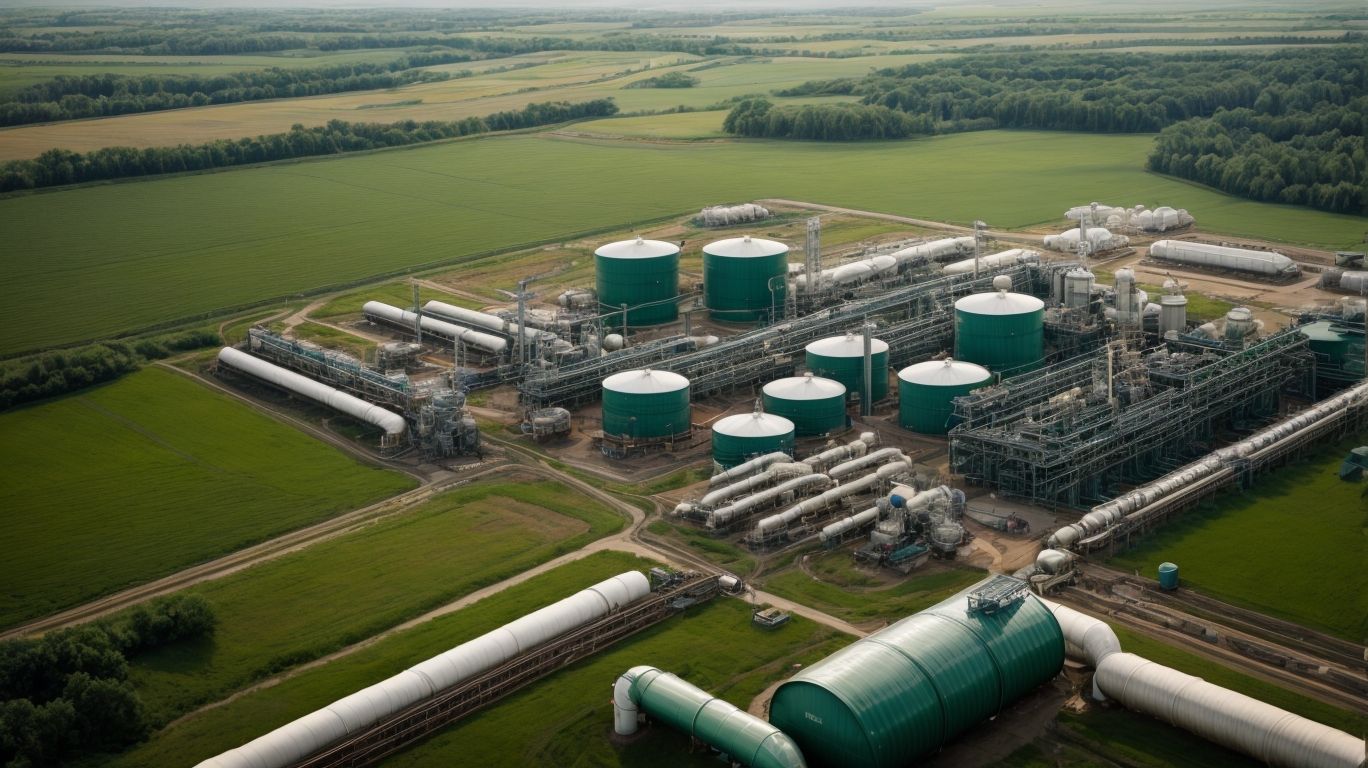Methane is a colorless, odorless, and highly flammable gas that is the main component of natural gas. It is essential to understand its chemical properties as it is one of the most abundant and potent greenhouse gases, contributing to climate change. In this comprehensive guide, we will delve into the chemical properties of methane, how it is produced, its uses, environmental impacts, and how it is measured and monitored.
Methane’s chemical properties are as follows:
- Molecular Formula: CH4.
- Molecular Weight: 16.04 g/mol.
- Boiling Point: -161.5°C (-258.7°F).
- Melting Point: -182.5°C (-296.5°F).
- Density: 0.716 g/L at 25°C (77°F).
- Solubility: Low solubility in water.
- Flammability: Highly flammable in the presence of oxygen.
- Reactivity: Methane is not reactive under normal conditions but can react with halogens in the presence of heat or light to form halogenated hydrocarbons.
Methane is primarily produced through both natural and human activities. The main natural sources include wetlands, termites, and methanogenic bacteria in the digestive systems of animals. Human activities such as fossil fuel extraction, landfills, and agriculture also contribute to methane production.
Methane has various uses, including being a fuel source for heating, cooking, and electricity generation. It is also used in chemical production processes, such as the production of ammonia and methanol. However, its use as a fuel source and in industrial processes also leads to significant environmental impacts.
Methane is a potent greenhouse gas, with a global warming potential 84 times higher than carbon dioxide over a 20-year time frame. It also contributes to air pollution and can lead to climate change and its associated effects.
To monitor and measure methane, various methods and technologies are used, including atmospheric monitoring, emissions tracking, and methane leak detection. These help in understanding the sources and levels of methane in the atmosphere and implementing strategies to reduce its emissions.
In conclusion, understanding the chemical properties of methane is crucial in comprehending its role as a greenhouse gas and its impact on the environment. Effective management and reduction of methane emissions are essential in mitigating its negative effects and promoting a more sustainable future.
Key Takeaways:
What Is Methane?

Photo Credits: Chemicalglossary.Net by Jeffrey Gonzalez
Methane is a colorless and odorless gas commonly found in natural gas and produced through various biological processes. It is composed of one carbon atom bonded to four hydrogen atoms. Methane is a potent greenhouse gas and plays a significant role in climate change. It is also a valuable energy source and is used for heating, cooking, and electricity generation.
In nature, methane is produced by microorganisms in wetlands, livestock, and the decomposition of organic matter. Throughout history, methane has been utilized for various purposes, including as a fuel source in ancient civilizations and as a component in the production of synthetic materials in modern industries.
What Are the Chemical Properties of Methane?

Photo Credits: Chemicalglossary.Net by Gary Clark
Methane is a colorless and odorless gas that plays a significant role in various industries and the environment. In this section, we will delve into the chemical properties of methane to gain a better understanding of its composition and behavior. We will explore the molecular formula and weight of methane, as well as its physical properties such as boiling point, melting point, and density. Additionally, we will discuss its solubility and reactivity, and the unique property of flammability that has made methane a valuable energy source.
1. Molecular Formula
The molecular formula of methane is CH4. Here is a step-by-step breakdown of the molecular formula:
- C: Represents carbon, an element that makes up the backbone of the molecule.
- H: Represents hydrogen, the element that surrounds the carbon atom, forming four covalent bonds.
- 4: Represents the number of hydrogen atoms bonded to the carbon atom in methane.
The discovery of the molecular formula of methane is credited to Alessandro Volta in 1778. Through his extensive experiments, Volta was able to determine the composition and molecular structure of methane, laying the foundation for our understanding of this important compound. His work paved the way for further research and applications of methane in various industries.
2. Molecular Weight
The calculation of the molecular weight of methane is a crucial aspect to consider in chemistry. Here is a step-by-step guide to understanding and determining the molecular weight of methane:
- Methane is represented by the molecular formula CH4.
- The molecular weight of an element is the sum of the atomic weights of its constituent atoms.
- To calculate the molecular weight of methane, you must first find the atomic weights of carbon (C) and hydrogen (H).
- The atomic weight of carbon is 12.01 atomic mass units (amu), while the atomic weight of hydrogen is 1.01 amu.
- Multiply the atomic weight of carbon by the number of carbon atoms in methane, which is 1, and add it to the product of the atomic weight of hydrogen and the number of hydrogen atoms in methane, which is 4.
- By performing this calculation, the molecular weight of methane is determined to be 16.04 amu.
3. Boiling Point
The boiling point of methane is a crucial characteristic that defines its physical state and behavior. Here are the main facts about the boiling point of methane:
- Methane has a boiling point of approximately -161.5 degrees Celsius or -258.7 degrees Fahrenheit.
- At temperatures below its boiling point, methane remains in a gaseous state.
- When the temperature increases and reaches the boiling point, methane undergoes a phase transition and transforms from a gas to a liquid.
- The boiling point of methane is affected by various factors, such as pressure. As pressure increases, the boiling point of methane also increases.
- The boiling point of methane is significantly lower compared to many other substances, making it highly volatile and easily vaporizable.
4. Melting Point
The melting point of methane is approximately -182.5 degrees Celsius or -296.5 degrees Fahrenheit. It is important to note that methane is a gas at room temperature and atmospheric pressure. However, under high pressure or very low temperatures, it can condense into a solid form. The solid state of methane is commonly referred to as methane hydrate. Methane hydrate is a crystalline structure where methane molecules are trapped within water molecules. It is mainly found in deep-sea sediments and permafrost regions. The melting point of methane hydrate is affected by pressure, with lower temperatures needed for melting at higher pressures.
5. Density
The density of methane is an important chemical property that plays a significant role in its behavior under different conditions. To better understand the density of methane, follow these steps:
- Density Definition: Density is defined as the measure of mass per unit volume of a substance.
- Methane Density: At standard temperature and pressure, the density of methane gas is approximately 0.717 kg/m³.
- Density Changes: The density of methane changes with variations in temperature and pressure. As temperature increases, density decreases, while increasing pressure results in a higher density.
- Applications: The density of methane plays a crucial role in determining the suitable methods for its storage and transportation.
- Comparisons: In comparison, methane has a lower density than air, causing it to rise and disperse quickly in the atmosphere. Additionally, it is lighter than other hydrocarbon gases such as propane and butane.
6. Solubility
Methane’s solubility is an important factor in understanding its behavior and impacts. Here are the key steps to consider when examining methane solubility:
- Research: Understand that methane is sparingly soluble in water, meaning it has a low solubility.
- Solubility Factors: Recognize that temperature and pressure directly affect methane solubility. As temperature decreases or pressure increases, methane solubility in water increases.
- Measurement: Utilize various methods like gas chromatography to accurately measure methane solubility in different conditions.
- Environmental Significance: Consider the implications of methane’s low solubility in water. It tends to accumulate in the atmosphere and contribute to climate change as a potent greenhouse gas.
7. Flammability
Methane is highly flammable and poses a fire hazard when exposed to an ignition source. To safely handle methane, follow these steps:
- Ensure proper ventilation in areas where methane is present.
- Keep sources of ignition, such as open flames and sparks, away from methane.
- Use explosion-proof equipment in areas where methane is stored or used.
- Implement proper grounding techniques to prevent the buildup of static electricity.
- Have fire extinguishers readily available and trained personnel on site.
To minimize the risks associated with methane, it is important to regularly inspect and maintain equipment, as well as provide proper training to employees. It is crucial to follow safety guidelines in order to prevent accidents and protect both individuals and the environment.
8. Reactivity
Reactivity is a crucial characteristic of methane, which greatly affects its chemical behavior and interactions. Here are some important points to note about the reactivity of methane:
- Combustion: Methane is highly flammable and readily reacts with oxygen, resulting in the production of carbon dioxide and water vapor.
- Oxidation: It reacts with halogens such as chlorine or bromine, leading to the formation of halogenated compounds.
- Substitution: In the presence of a catalyst, methane can undergo substitution reactions, where other functional groups replace one or more hydrogen atoms.
- Radical Reactions: Methane can participate in radical reactions, where free radicals are formed and react with other substances.
- Inertness: While methane is generally unreactive under normal conditions, it can be activated by high temperatures or catalysts.
To ensure safety and prevent unwanted reactions, it is important to follow proper handling and storage practices when dealing with methane. Regular monitoring and proper ventilation are also highly recommended.
How Is Methane Produced?

Photo Credits: Chemicalglossary.Net by Gerald Johnson
Methane is a widely used and highly impactful gas, but how is it actually produced? In this section, we will explore the various sources of methane, both natural and human-made. By understanding the different ways that methane is created, we can gain a better understanding of its chemical properties and potential impacts on the environment. From natural sources to human activities, let’s delve into the production of this powerful gas.
1. Natural Sources
Natural sources of methane include both biogenic and geologic processes:
- Wetlands: Methane is produced through the decomposition of organic matter in oxygen-depleted environments such as swamps, marshes, and rice paddies. These wetlands are the largest natural source of methane emissions.
- Termites: Certain species of termites have microbes in their digestive systems that produce methane as a byproduct of digestion. These termites can contribute significantly to methane emissions in tropical regions.
- Natural Gas Seeps: Methane can escape from natural gas deposits and seep into the atmosphere through cracks in the earth’s crust. These seeps can occur both on land and underwater.
- Cows and Other Ruminant Animals: Methane is produced as a byproduct of the digestive process in ruminant animals like cows, sheep, and goats. Microbes in their digestive systems break down plant material, releasing methane.
- Oceans: Methane can be released from the seafloor in areas with methane hydrates, which are ice-like structures that trap methane. This methane can then enter the atmosphere through the water column.
Fun Fact: Natural sources contribute to about 50-60% of total methane emissions, with wetlands being the largest individual source.
2. Human Activities
Human activities are a major contributor to methane emissions, worsening its impact on the environment. To help reduce these emissions, here are some steps that can be taken:
- Implement proper waste management practices, including capturing methane from landfills and wastewater treatment plants.
- Improve feeding practices and manage manure to reduce methane emissions from livestock.
- Regularly inspect and maintain natural gas infrastructure to control methane leaks.
- Promote the use of renewable energy sources and energy-efficient technologies to decrease reliance on fossil fuels.
By implementing these measures, we can lessen the negative effects of methane emissions and strive towards a more sustainable future.
What Are the Uses of Methane?

Photo Credits: Chemicalglossary.Net by Donald Lopez
Methane is a versatile chemical compound that has a wide range of uses in various industries. In this section, we will explore the different applications of methane and how it plays a crucial role in our daily lives. From being a fuel source to its use in chemical production and electricity generation, we will delve into the various uses of methane and its importance in our modern society. So, let’s dive into the uses of methane and how it contributes to our daily lives.
1. Fuel Source
Methane is a versatile fuel source with various uses. Here are steps to consider when utilizing methane as a fuel source:
- Extract: Methane is extracted from natural gas reserves or produced through processes like anaerobic digestion.
- Purify: Purification processes remove impurities, such as carbon dioxide and hydrogen sulfide, to enhance the quality of methane.
- Transport: Methane can be transported via pipelines or in compressed or liquefied form.
- Storage: Methane can be stored in tanks or underground facilities to ensure a continuous supply.
- Utilize: Methane can be used as a fuel for heating, cooking, electricity generation, and as a raw material in chemical production.
2. Chemical Production
Chemical production of methane involves multiple steps to convert raw materials into a usable form. These steps include:
- Extraction or synthesis of hydrocarbons rich in carbon and hydrogen.
- Purification of the hydrocarbons to eliminate impurities and unwanted by-products.
- Conversion of the hydrocarbons into methane through methods such as steam reforming or catalytic reactions.
- Separation and storage of the methane to ensure purity and prevent leakage.
Efficient and sustainable chemical production of methane can be achieved by optimizing reaction conditions, utilizing renewable energy sources, and implementing effective waste management strategies. By following these steps and suggestions, the production of methane can be carried out effectively while minimizing its impact on the environment.
3. Electricity Generation
Electricity generation is one of the main purposes of utilizing methane. The process involves several steps, which are outlined below:
- Methane extraction: Methane is extracted from natural gas reserves or produced from biogas generated by organic waste.
- Combustion: The methane is burned in a power plant’s combustion chamber, releasing energy.
- Turbine operation: The energy produced from the combustion drives a turbine, which converts the energy into mechanical power.
- Generator operation: The turbine is connected to a generator, where the mechanical power is transformed into electrical energy.
- Transmission: The electricity is transmitted through power lines to homes, businesses, and industries for use.
By harnessing the energy of methane, the process of electricity generation plays a vital role in meeting our daily power needs.
4. Heating and Cooking
Using methane for heating and cooking is a common practice in many households and industries. Here are some steps to follow when using methane for these purposes:
- Ensure proper ventilation to prevent the buildup of methane gas indoors.
- Install methane gas detectors to monitor any leaks or buildup of gas.
- Use a gas stove or oven specifically designed for methane fuel.
- Follow manufacturer instructions for lighting and operating the appliance.
- Regularly inspect and maintain gas appliances to ensure they are working safely and efficiently for both heating and cooking purposes.
- Keep flammable materials away from the stove or oven to prevent accidents.
- Never leave the stove or oven unattended while in use.
- Turn off the gas supply when not in use to prevent leaks.
By following these steps, you can safely and efficiently use methane for heating and cooking purposes.
What Are the Environmental Impacts of Methane?

Photo Credits: Chemicalglossary.Net by John Hernandez
Methane is a powerful greenhouse gas that has significant impacts on the environment. In this section, we will delve into the various environmental impacts of methane. From its role in the greenhouse gas effect to its contribution to climate change and air pollution, we will examine the ways in which methane can affect our planet. By understanding these impacts, we can better grasp the importance of studying and managing the chemical properties of methane.
1. Greenhouse Gas Effect
The phenomenon of the greenhouse gas effect occurs when certain gases in the Earth’s atmosphere trap heat and contribute to global warming. To better understand this effect, here are some key steps to keep in mind:
- Increased greenhouse gas emissions, such as methane, carbon dioxide, and nitrous oxide, intensify the greenhouse effect.
- These gases absorb and emit infrared radiation, preventing it from escaping into space.
- The trapped heat leads to a rise in global temperatures, causing climate change.
- Human activities, such as burning fossil fuels and deforestation, are major contributors to the greenhouse gas effect.
- To mitigate the greenhouse effect, it is important to reduce greenhouse gas emissions through sustainable practices and transitioning to renewable energy sources. Understanding the Chemical Properties of Methane: A Comprehensive Guide
Individuals can take action to address the greenhouse gas effect by making eco-friendly lifestyle choices, supporting clean energy initiatives, and advocating for strong environmental policies. Together, we can combat climate change and protect our planet for future generations.
2. Air Pollution
Air pollution is a major environmental concern associated with methane. Once released into the atmosphere, methane reacts with other pollutants, contributing to the formation of ground-level ozone and smog. These pollutants can have harmful effects on human health, causing respiratory problems and worsening conditions like asthma. In addition, methane itself is a potent greenhouse gas that traps heat in the atmosphere and contributes to global warming. It is crucial to monitor and reduce methane emissions in order to mitigate air pollution and its related impacts on health and the environment.
In 1952, the Great Smog of London occurred, caused by a combination of cold weather, air pollution from coal burning, and calm winds. This resulted in a thick layer of smog settling over the city for five days, leading to thousands of deaths. This event brought attention to the severe health effects of air pollution and led to the implementation of stricter regulations and the development of cleaner energy sources.
3. Contribution to Climate Change
Contribution to climate change is a significant concern related to methane emissions. To understand its impact, consider the following steps:
- Methane is a potent greenhouse gas, trapping heat in the atmosphere and contributing to global warming.
- When released into the atmosphere, methane absorbs more heat than carbon dioxide, exacerbating the greenhouse effect.
- Human activities, such as agriculture, fossil fuel extraction, and waste management, are major contributors to methane emissions.
- Specific sources include livestock farming, rice cultivation, coal mining, and landfill sites.
- Methane contributes to the formation of ground-level ozone, a harmful air pollutant that affects human health and damages crops.
- To mitigate methane’s impact on climate change, efforts are being made to reduce emissions through improved waste management practices, technological advancements, and policy interventions.
How Is Methane Measured and Monitored?

Photo Credits: Chemicalglossary.Net by Andrew Lee
In order to fully understand the chemical properties of methane, it is crucial to also understand how it is measured and monitored. This section will delve into the various methods used to track and detect methane, including atmospheric monitoring, emissions tracking, and methane leak detection. By exploring these different techniques, we can gain a better understanding of how methane is monitored and the importance of accurately measuring its levels in the environment.
1. Atmospheric Monitoring
Atmospheric monitoring is crucial for studying the levels of methane and its impact on climate change. Follow these steps to effectively monitor methane levels:
- Utilize instruments like gas analyzers to measure the concentration of methane in the air.
- Gather air samples from various locations, including cities, industrial areas, and natural environments.
- Analyze the samples in laboratories to determine the levels of methane present.
- Regularly monitor methane levels to track any changes over time.
- Correlate methane data with other environmental factors to gain a better understanding of its sources and effects.
To enhance atmospheric monitoring, governments and organizations can invest in advanced technologies, establish comprehensive monitoring networks, and collaborate internationally to improve data sharing and analysis.
2. Emissions Tracking
Emissions tracking is crucial in assessing and mitigating the environmental impacts of methane. Here are the steps involved:
- Identify emission sources: Determine the major sources of methane emissions, such as oil and gas operations, agriculture, and waste management.
- Quantify emissions: Use measurement techniques like remote sensing, aerial surveys, and ground-based monitoring to track and quantify the amount of methane released.
- Analyze data: Analyze the collected data to identify emission trends, hotspots, and potential areas for reduction.
- Develop strategies: Use the data to develop targeted strategies for reducing emissions, such as implementing leak detection and repair programs.
- Track progress: Continuously monitor and track emissions to evaluate the effectiveness of implemented measures and identify areas for improvement.
Fact: Methane is responsible for approximately 25% of global warming caused by human activities.
3. Methane Leak Detection
- Regular inspections: Conduct routine inspections of equipment, pipelines, and storage facilities to detect potential methane leaks.
- Use of detection technology: Utilize advanced methane detection technologies such as infrared cameras or laser-based sensors to identify and locate leaks.
- Implement maintenance procedures: Establish regular maintenance procedures to promptly repair any identified methane leaks.
- Train employees: Provide training to employees on methane leak detection and the importance of reporting any leaks they encounter.
- Collaborate with experts: Seek assistance from experts in methane leak detection to ensure a comprehensive approach to leak prevention.
In 2015, a major methane leak was detected in California’s Aliso Canyon natural gas storage facility. The leak, which lasted for several months, resulted in the release of approximately 97,100 metric tons of methane into the atmosphere. This incident highlighted the importance of effective methane leak detection and the need for improved safety measures in gas storage facilities.
Frequently Asked Questions
What is methane and what are its chemical properties?
Methane is a colourless and odourless gas that occurs naturally and is also produced by human activities. It is the simplest member of the paraffin series of hydrocarbons and is known to be one of the most potent greenhouse gases. Its chemical formula is CH4. Some important chemical properties of methane include its specific gravity of 0.554, slight solubility in water, and its ability to readily burn in air, forming carbon dioxide and water vapour.
What are the sources of methane?
In nature, methane is produced by the anaerobic bacterial decomposition of vegetable matter under water, making wetlands the major natural source of methane. Other natural sources include termites, volcanoes, ocean floor vents, and methane hydrate deposits. Human activities such as natural gas extraction, coal processing, biomass burning, and waste management also contribute to methane production.
What are some uses of methane?
Methane is an important source of hydrogen and some organic chemicals. It reacts with steam to produce carbon monoxide and hydrogen, which is used in the production of ammonia for fertilizers and explosives. Other valuable chemicals derived from methane include methanol, chloroform, carbon tetrachloride, and nitromethane. Incomplete combustion of methane yields carbon black, which is used in rubber production, including in automobile tires.
What is the role of methane as a greenhouse gas?
Methane is known to be a potent greenhouse gas, contributing to global warming. Its ability to trap heat in the atmosphere is 28 times greater than carbon dioxide. Human activities such as natural gas extraction and coal processing contribute to the increase of methane in the atmosphere. Methane levels have been steadily rising, and it is a major concern in the fight against climate change.
How is methane identified in databases?
Methane can be identified in different databases using various identifiers, such as its NIST chemistry webbook, KEGG Compound, Beilstein Registry Number, CAS Registry Number, Gmelin Registry Number, and Reaxys Registry Number (1718732). These identifiers help researchers to find more information about the chemical and its properties.
How is methane formed?
Methane is formed over many years through the decomposition of deposited vegetation under extreme pressure. This process leads to the formation of fossil fuels, such as coal, oil, and natural gas. This is why methane is often found in these sources and is extracted for various industrial and domestic uses.
